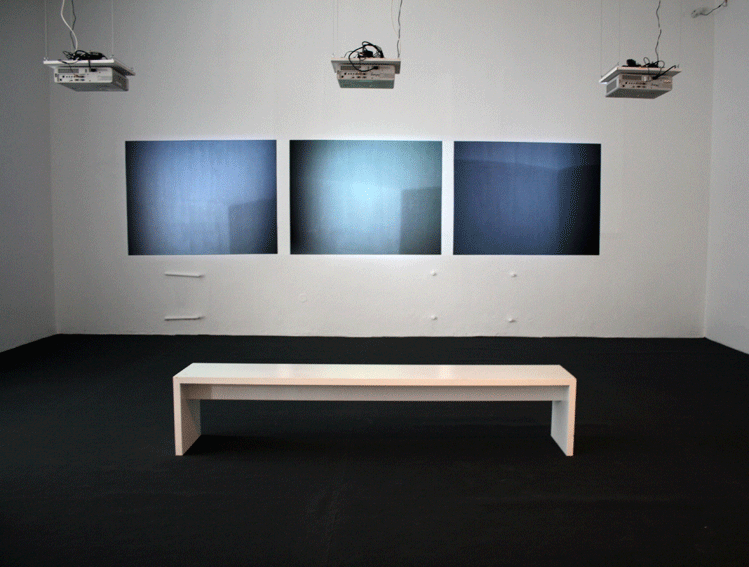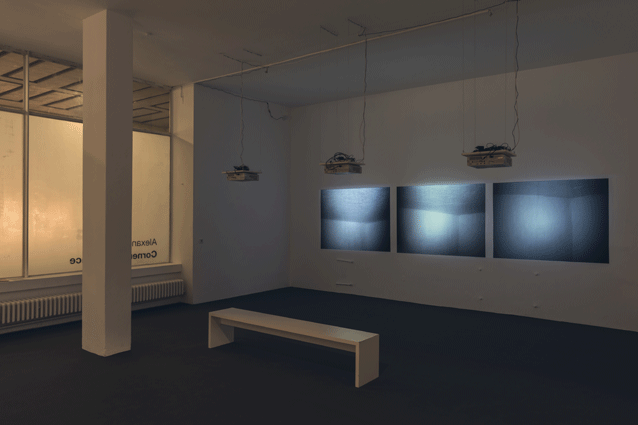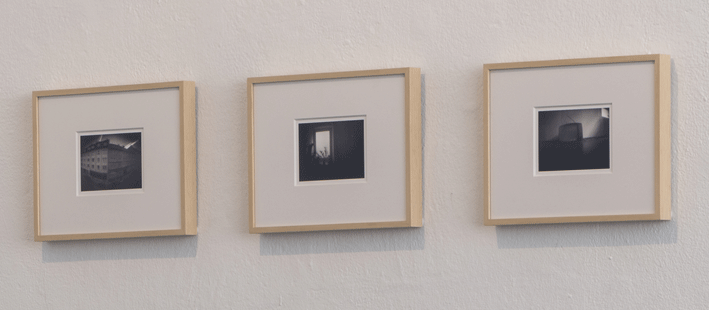Cave Paintings
When stepping into the “Corner Surveillance +24/7 Photography“ exhibition in the Artothek Munich, you enter into an acoustic and visually subdued situation. The large window facing the busy street was painted opaque, dark gray carpet was laid on the concrete floor, and the illumination was reduced to a single spotlight. The place seems to abandon the competition with its urban environment and devote itself to the two sparingly arranged works. The two series, both by media artist Alexander Steig, are a wall-filling video triptych on one side and a small three-part series of black-and-white photographs on the other.

The 3-channel closed-circuit video presentation “Corner Surveillance,“ developed for the room, shows the live transmission of three surveillance cameras, which the artist has placed in the upper corners of the room to focus these corners. The pictures are projected accurately onto the black primed projection surfaces of the wall via three video projectors. On display are large-format, diffuse, blue-gray coloured areas. Due to varying contrasts, you can see static “paintings“ that can only be recognized as a continuous real-time film by the change of daylight. The museum-like presentation with the visitor bank indicates a longer development time and deployment of the theme.
The photo series “24/7 Photography,“ in contrast, shows three small-format black-and-white prints. These are one- to three-week long exposures of pinhole cameras onto photo paper with the following motifs: street, bathroom, and TV. The blurring documents the effaced, passing, invisible life of these different places. The apparent or actual non-eventuality of his video surveillances, says the artist, is a key criteria of his media research approach. In the static-looking video projection, the observer waits for the progression of a storyline; the photos show traces of past activity. The interesting aspect is the exchange of functions: the photography tells a story through the extreme long-term exposure, while the „moving image“ remains a documented, static situation. Only the slow change of light changes the projection imperceptibly until the surveillance cameras automatically switch to infrared mode as darkness falls and thus illuminate the murals in a peculiar luminescence.
There is little to see here. Everything visible is expectable and well known. Why do artists think they have to show us what we see every day anyway? Didn’t the cave dwellers on the eastern Swabian Alb, who 5000 years after the end of the ice age made small objects modelled on their surroundings, clear the way for Homo sapiens to settle Central Europe? Everyday representations, landscapes, and portraits were the primary artistic themes until, after 35,000 years, industrially manufactured products of use were declared unchanged as art. Basically, nothing has changed since the beginning of the human work. From the beginning, the depicted motifs were placeholders for super- ordinate topics. For thousands of years, higher powers were summoned to assist in hunting and harvesting, rulers were represented as gods to impress, control, and oppress the people, portraits were polished to fool the future parents-in-law, and so on. With increas-ing individualization, people began to look more critically at their social structure and environment and make political commentary and accusations. Of course, Alexander Steig does not just want to show us diffuse room corners or blurry photos. Rather, they serve as ”aesthetic vehicles,” as reference images of his world-view and experience. They can be read as a silent commentary or quiet questioning of current socio-political tendencies, especially in the area of ever-closer circles of media control or even the loss of privacy. In the mind‘s eye, of course, images immediately appear on surveillance cameras in dim, empty rooms, images of controlled places that could be entered by a suspicious subject at any time and whose deviant action could be sanctioned by the given social norm. This leads to the question of the supposed autonomy over one‘s own privacy and the increasing threat of the state to the continuously “stalked” citizen.
Well-known pictures have started a maelstrom of memories caused by what was seen and experienced. It really only needs a priming, an illumination in the dark (of the cave) to make a comparison. The offer of quiet contemplation of the unpretentious video images and pale photographs and their uneventfulness is in contradiction to this maelstrom you want to tame but ultimately cannot control. Thus, Alexander Steig creates a low-event, quasi-cultic, or spiritual ”experience space“ that, precisely because of its formal turning-away from the world, causes reflection on the events outside the cave.
Martin Schmidt
Translation: Pete Alcorn, San Francisco
(Catalogue "Corner Surveillance, Munich)

